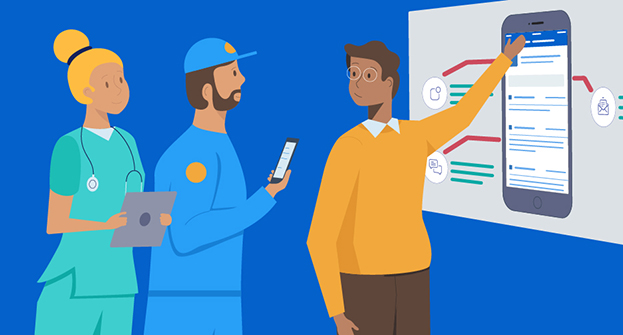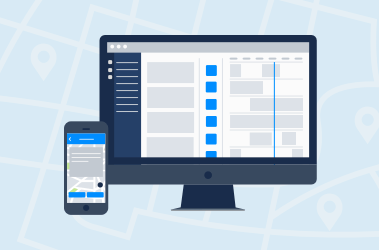A mobile workforce, as part of the broader global deskless workforce, is comprised of people who are on the move and may work at multiple locations, even in the course of a single day.
These workers are not anchored to a desk: not at a traditional office, remote office, or co-working environment. Examples of mobile workers include field service technicians, independent contractors, home healthcare providers, field sales representatives, delivery workers, and traveling consultants.
With more and more industries relying on a mobile workforce to deliver services and products outside of the office, it is crucial to understand the trends, challenges, and solutions associated with mobile work.
Mobile Workforce Trends
The convergence of several key trends has put the mobile workforce in the spotlight like never before. While mobile workers have always contributed to a share of the workforce, there is a fresh appreciation for the scope and complexity of this segment’s impact on business.
80% of the global workforce is now deskless, and the mobile workers within that category require unique tools and processes for success. This means that nearly 2.7 billion people within the top eight deskless industries (agriculture, education, healthcare, retail, hospitality, manufacturing, transportation, and construction) rely on proper mobile workforce management. . As businesses work to improve their efficiency, retain customers, and stay competitive, there is an enormous opportunity to improve how this segment of the workforce is managed, deployed, and supported.

Let’s examine a few trends that have driven the movement to improve mobile work:
Millennials make up most of today’s workforce
It’s estimated that by 2030, 75% of the U.S. workforce will be millennials. The aging of the current workforce and the rise of millennials in the workplace has resulted in workforce changes. Millennials are the first generation to have grown up with technology, and they expect to use tech in the workplace to make their jobs easier.
Millennials are driving significant changes in how their companies use technology, including embracing workforce automation to cut down on bureaucracy and using available technologies to work from wherever they are.
Studies show that when millennials search the job market, one important factor of their decision is how the company uses technology to improve everyday work. Millennials are more likely than their workforce predecessors to opt for jobs that use technology to improve productivity—including the ability to work outside the traditional office setting. Millennials are also more likely to value flexibility in the workplace, which new technologies enable more easily than in the past.
Millennials are used to communicating and collaborating from afar with advanced technology solutions, and they expect to be equipped with modern tools that increase quality and productivity at work. Senior leaders across industries must adapt to this trend to remain competitive and retain top millennial talent.
Technology closes workforce gaps
Thanks to a wide range of technologies, managing a mobile workforce is more streamlined than it used to be. Faxes and office phone lines have been replaced by cloud applications, smartphones, tablets, wearable devices, and the omnipresent Wi-Fi and 4G. What’s more, the number of smartphone users today is estimated to exceed 3 billion, which has led to an unprecedented amount of digital access.
The advent of new, streamlined technology solutions makes it simpler to solve problems, communicate with team members, update work schedules, and keep track of work in progress.
If a service professional is unable to resolve a technical issue in the field, it’s easier than ever to communicate with coworkers or managers who are either working from an office or out in the field. The worker can also remotely access systems to search for solutions, find examples of similar issues encountered in the past, or submit requests for assistance.
Companies increase investment in technology to manage mobile work
Many enterprises have started to realize the need to invest more in technologies that support mobile workforce operations. Even industries that have traditionally lagged behind in technology investment, such as healthcare and manufacturing, are now increasingly adopting mobile workforce management solutions.
Companies that leverage technology to support their mobile workforce have seen amazing results. For example, automation and smarter data management allowed New Jersey Respiratory Associates to reduce back office expenses and take on more accounts, growing 20% for three consecutive years. ServiceMaster Clean Vancouver improved its field service operations to deliver more than 1,000 onsite service appointments each month, with only 80 employees and 25 vans on the road.
In addition to investing on an individual company level, this trend is also playing out in the larger investment market. Venture capital firms have started to build their portfolio of deskless technologies, and millions of dollars are flowing into mobile workforce management solutions as a result. However, investment in mobile workforce management technology still has incredible room to grow; in fact, it’s estimated that only 1% of software investments are currently supporting the deskless workforce.

Challenges Unique to the Mobile Workforce
The mobile workforce, and the individual workers within it, face unique challenges in the workplace. These are the key challenges that mobile workforce management solutions must solve in order to effectively support the deskless workforce:
Communication
Unlike employees working in an office location who can hop into a conference room for a spontaneous meeting, mobile workers require a more sophisticated and streamlined tool to communicate effectively. Mobile workers who are well-connected to their fellow workers, their leadership, and administrative staff are more efficient, productive, and satisfied with their jobs.
Mobile workforce management solutions should streamline communication between coworkers and the back office. While in the field, workers require both direct and contextual communication methods to ensure success. The right mobile workforce management software offers both, with direct tools (like real-time SMS messages and push notifications) for sharing schedules, detailed instructions, and status updates and contextual tools (like location data) for visibility and routing.
By remaining well-connected with their peers, mobile workers can leverage a wider knowledge base and resolve issues faster. Additionally, they feel more connected to coworkers, which boosts morale and job satisfaction.
The customer, too, stands to benefit from fast-paced communication. For example, a cleaning service that uses a mobile workforce management platform can provide a specific appointment time, rather than a long “estimated service window.” This precise time gives the customer peace of mind and prevents frustration from waiting for a technician to arrive.
A platform that offers real-time updates can provide clear visibility into the availability of workers. When a healthcare worker completes an appointment and marks it in the system, the platform can immediately flag other patients that require service near the location of the worker. This improves productivity, reduces travel time, and increases the number of patients who receive care in a given day.
Integration
While technology solutions can help bridge the gap between mobile workers and those working in an office, many mobile workers are overburdened with multiple, disparate platforms. When a company uses a bundle of systems to cover important gaps, deskless workers are stuck navigating multiple interfaces and platforms to get the work done. Plus, when mobile workers are forced to use multiple systems due to the nature of their work—when in-office workers have an easier solution—it can exacerbate the divide between your deskless and operations teams.
The best solution for deskless workers is an integrated mobile workforce management system that gives everyone access to the right information at the right time.
The benefits of using an integrated mobile workforce platform include:
- A single, centralized system for training
- Increased productivity, as deskless workers don’t need to switch between platforms
- Elimination of data silos created from multiple systems, leading to more accurate business insights
- Real-time scheduling and updates
- Improved workflows as a result of seamless data sharing
- A single source of truth for job notes, customer history, and more.
Usability
User experience and design are not just about aesthetics anymore—they have a significant impact on the productivity of your workforce.
38% of web surfers will stop engaging with a site if they find it unattractive or if it takes too long to load. And for better or worse, mobile workers have the same high expectations for their workplace technology as they do for their devices at home.
Your mobile workers use tools and technologies in their day-to-day operations, but it’s often higher-level employees who make the purchasing decisions. Too often, UX and usability is not given priority by the managers, who are not using the product everyday.
A strong workforce management system should account for the convenience and use of the actual end-user: your mobile worker. Here are a few factors to consider:
- Easy, intuitive interface: Since mobile employees come from diverse backgrounds and industries and may not have a deep technological background, it’s important to make the user interface intuitive and easy to use.
- Mobile-first approach: Modern companies must adopt a mobile-first approach to account for the unpredictability mobile workers face in the field.s.
- Speed and real-time updates: These are essential for a seamless experience. Delay in loading or synchronization with the back end leads to frustrated users and customers.
- Ability to work with limited or no connectivity: Your mobile workforce management tool should be accessible to deskless workers, regardless of where they are. An inability to connect to a network shouldn’t put your mobile workers’ day on pause.
Accountability
Traditionally, enterprises have experience in managing employees within an office, where it’s possible to have multiple interactions within a day. In such a setup, tracking job completion, understanding worker availability, and equipping employees with essential resources is a relatively easy feat.
However, when most of the work happens outside the office, where the workforce is a blend of part-time and full-time employees and independent contractors, companies have to tailor their strategies to improve mobile workforce visibility.
From the employer’s perspective, this means understanding what work is being performed and by whom, and receiving valuable data about the customer interaction and future needs. From the worker’s perspective, this means having access to the customer information and tools they need to deliver the best possible service.
For example, mobile workers are better prepared to answer customer questions on the spot when they have easy access to appointment details and customer history in a centralized mobile app. Once the appointment is complete and the worker has added data from the field into the system, the company is better equipped to make data-driven business decisions.
When both of these sides work together to improve accountability, it creates a culture of engaged employees who want to put their best foot forward and dedicated leaders who want to equip and empower their deskless workers.
Employee Satisfaction
Although key trends are certainly making a dent in the way companies make strategic and financial decisions, the question remains: Are organizations doing enough to cater to the mobile workforce? Are they doing everything they can to motivate, retain, and empower mobile workers for a better employee experience?
Even though mobile workers make up a huge portion of the workforce, their needs have been largely overlooked up to this point. It is not surprising, then, that mobile worker industries suffer the most from employee turnover.
In order to improve the employee experience—and therefore, employee retention—employers should focus on empowering mobile workers through technology. Technology solutions should streamline communication, automate routine tasks, and empower mobile workers to provide excellent service. When deployed effectively and tailored to the mobile workforce, these tools improve day-to-day operations in ways that leave employees feeling more fulfilled and more in control of the customer experience.

A Technology Solution for the Modern Mobile Workforce
The mobile workforce has grown dramatically in recent years, and there’s no sign of stopping. High customer expectations and the desire for streamlined technology solutions at work will continue to drive companies to invest in deskless workforce solutions.
The mobile workforce management platform you choose should be able to add value for all three key parties: mobile workers, customers, and business leaders. It should be powerful enough to manage different types of employees, yet flexible enough to meet the unique needs of your industry and your deskless workers.
Skedulo’ intelligent mobile workforce management software helps companies empower their mobile workers, serve more customers, and collect valuable data from the field. Learn more about what to look for in a mobile workforce management solution, or book a free demo today!


